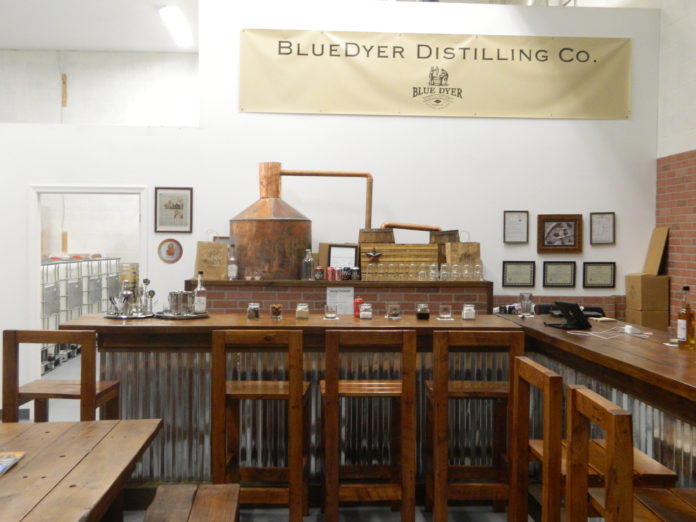
It’s 1928. A bio-chemist and a bootlegger walk into a bar…
OK, maybe they didn’t.
But they did hide in the woods and become successful rum-runners throughout the prohibition in Southern Maryland and Virginia, and now they’ve passed on their trade secrets to Blue Dyer Distilling owners Walker Dunbar and Ryan Vierheller.
Embracing both science and a bit of family history, owner Ryan Vierheller based his business on that of his bootlegging grandfather and great grandfather, David Wirman and Sr., respectively.
“Growing up, my granddad was a huge figure in my life,” said Ryan. “I worked with him for 15 years every summer as his assistant in all the things he did; he had a lot of rental properties that he maintained. I heard all of his stories about him and his father, who were pretty actively involved in moonshining and bootlegging throughout prohibition; it was a big element in his life. His first 52 acres was from bootlegging proceeds.”
As most know, bootlegging became a part of American life during the prohibition era, a short time in United States history when it was illegal to produce, sell or transport alcohol. Twelve 40-gallon stills and almost 90 years later, it was his grandfather’s then-illegal pursuits that taught Ryan how to run a distillery room, and offered him inspiration for the company’s name.
“We found out that our first relatives who came to U.S. were from Holland and settled in Pennsylvania. My relative, William Wireman, was trained as a chemist but made a living as a blue dyer and a grain farmer. A blue dyer is an old profession of making dye for fabrics and it employs the same equipment as distilling alcohol.” Because of this Ryan’s granddad went by the nom de guerre ‘Blue Dyer’ while bootlegging instead of his real last name. “I’m a 10th generation from the original blue dyer, and still running stills and making liquor,” said Ryan.
Ryan and Walker began planning the distillery back in 2014 and officially opened their doors this summer in July. With a background in law enforcement and culinary arts, Ryan admits that making the liquor was actually the easiest part of the entire process. “I’ve seen liquor made since I was a child; it’s the business that’s hard.”
Luckily Ryan has his wife, Jasmine, by his side. “Our relationship was built creating this distillery. It’s truly been a two-man, one-woman team. She got involved and learned both our jobs,” he said. “She’s the only person who has done everything.” Jasmine’s mother is also a rum connoisseur, adding to their family tradition of knowledge.
Inside of the distillery, visitors will find a tasting room full of wood furniture from granddad’s farm and a handmade 100-year-old copper boiler pot on display at the bar. The accompaniments are all made from rough-cut oak, with 10-foot harvest tables and benches crafted from pine. “It’s a very rustic, country atmosphere.”
The rest of the facility is a little industrial, including electrically-fired stills. Each tour and tasting lasts around half an hour, give or take. “It depends how much you want to know about the science.” Each customer who takes the tour can purchase up to three bottles at the end.
Currently, their original Gold Blue Dyer rum can be found in almost 60 places around the three Southern counties, from restaurants to liquor stores. They are in the process of finishing a dark sipping rum, their second product, which is expected to debut this Christmas. Next year they are hoping to introduce a spiced rum as well.
What’s unique about Blue Dyer rum, other than their history, is their manufacturing process and in turn, the product’s taste. “We don’t make rum the same way as 99 percent of distilleries,” Ryan said. “The standard Caribbean method for rum is high proof and utilizes a used barrel, so that when it comes out it’s not completely finished and a little rough. Then they add coloring, caramel and sugar.”
Whiskey on the other hand is all from the charred wood in the barrels – no additional flavors. “We thought, why is nobody doing this with rum?” he said. “We wanted more natural and organic flavors, so we extract our flavor and color just from our charred wood. We experimented with nine different barrels until we found the right one. In the end, we were looking for a traditional caramel flavor.”
The pair decided on using newly charred barrels as opposed to used barrels. “Our Gold Blue Dyer Rum tastes like a mix of rum and light whiskey – it has oak and wood notes with a hint of vanilla. We’re going to stick with flavoring all of our products as naturally as possible.”
Visit Blue Dyer Distilling Co., Inc. located at 52 Industrial Park, Suite 15/16 Waldorf, MD 20602. Call 301-674-8832 or online at: bluedyerdistilling.com










